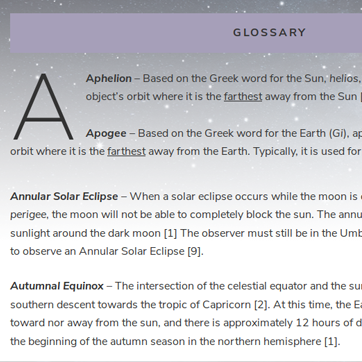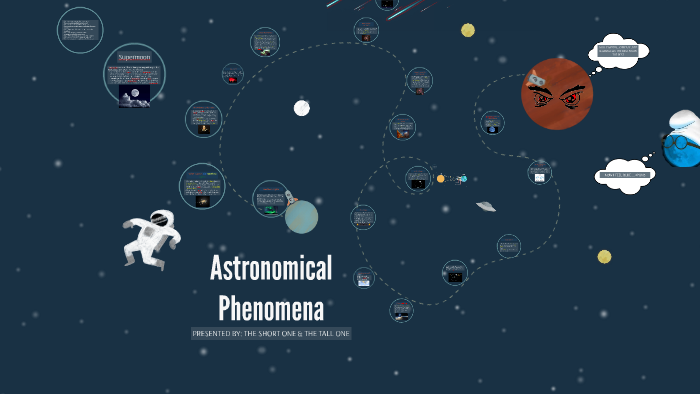
Halley's Comet reaches its perihelion, the closest point to the Sun-the last return reached its perihelion on February 9, 1986. Periodic comet 15P/Finlay will pass 0.0334 AU (5.00 million km 3.10 million mi) from Earth. (Eclipse predictions by Fred Espenak, NASA/GSFC). This year will see the very rare occurrence of two total solar eclipses in a single calendar year (on January 5 and December 26). Īugust 29 – A Total Penumbral Lunar Eclipse will occur, the first since 2006. ĭecember 6 – The closest supermoon of the century will occur.
#Names of astronomical phenomena full#
The next full moon on a leap day will not occur until February 29, 2124. There will be a rare full moon on a leap day this event happens roughly once every century. The last was on July 7, 1959, and the next will occur on October 21, 3187, although some sources claim it will occur on October 6, 2271.Ī METI message called Teen Age Message sent from the 70-metre Eupatoria Planetary Radar will arrive at its destination, 47 UMa. Ī METI message Cosmic Call 2 sent from the 70-metre Eupatoria Planetary Radar arrives at its destination, 55 Cancri.Īnother METI message Cosmic Call 2 sent from the 70-metre Eupatoria Planetary Radar arrives at its destination, HD 10307. The Great Red Spot on Jupiter's atmosphere will become circular according to calculations based on its reduction rate at present. Planetary alignment of Mercury, Venus, Mars, Jupiter, Saturn and the crescent Moon Īn annular solar eclipse will occur over the Northern Hemisphere. The next triple ring plane crossing of Saturn will occur. Ī solar eclipse will be seen in Australia and New Zealand.

Īn annular solar eclipse will be visible in northern South America, the Atlantic Ocean and Africa. Īn annular solar eclipse will occur in the Caribbean Sea, Atlantic Ocean and western Africa. Ī METI message Cosmic Call 2 sent from the 70-metre Eupatoria Planetary Radar on July 6, 2003, arrives at its destination, HIP 4872. Projected return to Earth orbit of object J002E3, the discarded S-IVB third stage of the Apollo 12 Saturn V. The first of the twin eclipse pair happened from December 21 to 22 in 2010.Īn annular solar eclipse will be visible in Northern Africa, the Balkans, and Russia.Ī total solar eclipse will be seen in Southern Africa and Australia.Ĭomet 55P/Tempel–Tuttle (source of the November Leonids) comes to perihelion. The December 2029 lunar eclipse, the second of two Metonic twin eclipses, will occur. With an umbral eclipse magnitude of 1.84362, it will be the largest total lunar eclipse of the 21st century. Near-Earth asteroid (99942) Apophis will pass Earth at a relatively small distance of 31,200 km (19,400 mi) above Earth's surface, closer than some geosynchronous satellites. NASA's New Horizons spacecraft is scheduled to leave the Solar System. Some points of the list miss the last date of the events.Ī total solar eclipse will be visible in the Central Pacific Ocean, northern Mexico, eastern, southwestern and central US, southeastern Canada and northern Atlantic Ocean.Īsteroid (137108) 1999 AN 10 will pass within 388,960 km (0.0026 AU) of Earth.Ī total solar eclipse will be visible across Australia, including Sydney, and New Zealand.

Nor does it list astronomical events that have yet to be discovered. In particular, it does not include solar eclipses or lunar eclipses unless otherwise notable, as they are far too numerous to list (see below for articles with lists of all these).

These are by no means all events, but only the notable or rare ones. ( Learn how and when to remove this template message)Ī list of future observable astronomical events.

( August 2023) ( Learn how and when to remove this template message) Statements consisting only of original research should be removed. Please improve it by verifying the claims made and adding inline citations. This article possibly contains original research.


 0 kommentar(er)
0 kommentar(er)
